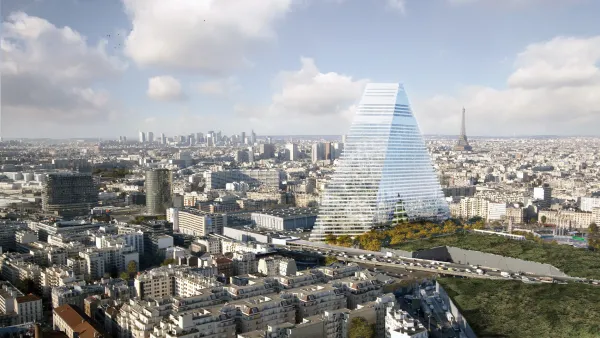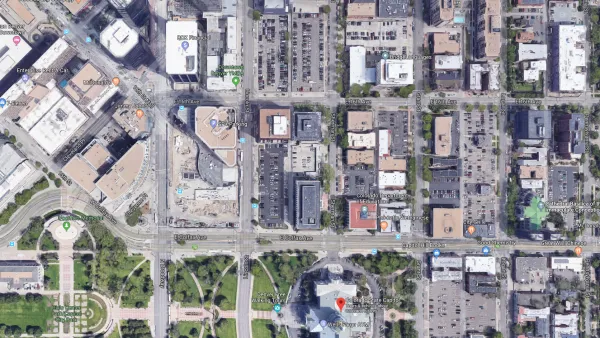Should planners be pushing to remove height limits to meet the growing demand for housing?
Last week, Alissa Walker wrote a piece in Gizmodo with the headline "Tall is Good: How a Lack of Building Up is Keeping Our Cities Down." Walker argues that buildings taller than 4 stories need to be built to keep cities from pricing out its lower-income citizens, and that cities should be removing height limits and encouraging super tall - and thin - buildings. Walker was inspired by a breathtaking CGI vista in Spike Jonze's new film set in the future showing a Los Angeles full of scintillating skyscrapers.
I agree, of course, that well-designed density creates a host of benefits, connecting people socially and economically, improving health, reducing energy use and pollution, etc. I also was happy to see Gabe Metcalf at SPUR advocating for finding ways to build taller in San Francisco, which desperately needs more housing to meet demand and relieve some pressure on rents. But whether skyscrapers are the one true solution for most American cities is still a matter of debate. The great architect Leon Krier, who influenced many New Urbanists, writes passionately in the recently released 2nd Edition of the Charter of the New Urbanism book that buildings should have "an unsurpassable maximum of five floors - in short, to walkable building heights." James Howard Kunstler argues that skyscrapers will quickly become irreperable relics when peak oil and climate change transform our environment.
I'm personally not an extremist - after an extensive look at the issues around skyscrapers a few years back in Planetizen, I concluded that there is nothing inherently wrong with them. And as Alissa points out, most of our negative impressions of tall buildings are fueled by media depictions of dystopias and a history of sticking poor people in "towers in the park", but that doesn't mean that skyscrapers can't be built that effectively meet the street.
But as a planner mellowing over the years and surrounded by the expertise of CNU thought leaders, I feel like an overemphasis on height is misplaced. Of course in New York City, it would be a crime to build anything under 6 stories, maybe even under 20 stories. But New York is an anomaly - should Kansas City be focusing entirely on skyscrapers? And Alissa's Los Angeles (where I also live), which has blocks and blocks of poorly-used, undervalued buildings and land - shouldn't we be fixing the streetscapes and populating those 3-6 story structures before shooting new skyscrapers up?
How about Mesa, Arizona, where CNU staff recently visited? In Mesa, the mayor and local developers are all on board to create more walkable, urban neighborhoods, but they can't make a building over 5 stories pencil out. They also have endless miles of streets with enormous setbacks. If the need is greater to create street life than to build up, where should the emphasis be?
This is my central concern about skyscrapers; Unless they are already in a densely-packed city, or there is a huge pent-up demand, super-tall buildings have the potential to drain life off of the street. There are a lot of ways to structure a building envelope to house a significant number of people and a mix of uses without going up, up, up. While I'm nowhere near advocating that we follow Krier's advice and ban any building taller than 5 stories, I'm of the growing opinion that modesty is necessary and a healthy respect for scale is the way to go. Paris is often cited as the model for the sort of lovely densification that can be acheived with 4-story buildings, but Madrid is another potent example. Not all cities can be a Paris or Madrid, but not all cities can be a Hong Kong either. And with decades of backlash against poorly-constructed apartment buildings and towers, perhaps we should be concentrating building places of quality over height?
And while local height limits can sometimes be too restrictive, the type of 2-4 story, mixed-use development I'm talking about faces non-negotiable Federal obstacles that have kept this midrange option (that I think is crucial to city infrastructure) from getting built. Developers are actually incentivized to "build high to qualify" for Fannie Mae or Freddie Mac mortgages, which may lead to density that the market won't support.
What I think we really need are developers, architects and planners willing to embrace the on-the-ground conditions, build to meet the street in a lively and interactive manner that supports neighborhood commerce and social settings, and adds housing in inventive ways that support the needs of families of all sizes and income levels. If a skyscraper meets those needs, so be it. But I think more often the result would be a building with variety of levels, from 2-6 stories, that fit together into a community.

Analysis: Cybertruck Fatality Rate Far Exceeds That of Ford Pinto
The Tesla Cybertruck was recalled seven times last year.

National Parks Layoffs Will Cause Communities to Lose Billions
Thousands of essential park workers were laid off this week, just before the busy spring break season.

Retro-silient?: America’s First “Eco-burb,” The Woodlands Turns 50
A master-planned community north of Houston offers lessons on green infrastructure and resilient design, but falls short of its founder’s lofty affordability and walkability goals.

Test News Post 1
This is a summary

Analysis: Cybertruck Fatality Rate Far Exceeds That of Ford Pinto
The Tesla Cybertruck was recalled seven times last year.

Test News Headline 46
Test for the image on the front page.
Urban Design for Planners 1: Software Tools
This six-course series explores essential urban design concepts using open source software and equips planners with the tools they need to participate fully in the urban design process.
Planning for Universal Design
Learn the tools for implementing Universal Design in planning regulations.
EMC Planning Group, Inc.
Planetizen
Planetizen
Mpact (formerly Rail~Volution)
Great Falls Development Authority, Inc.
HUDs Office of Policy Development and Research
NYU Wagner Graduate School of Public Service




























